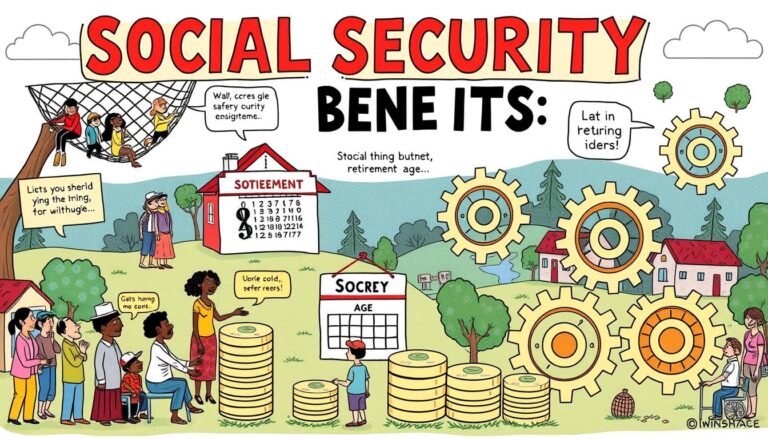Medicare and Retirement Healthcare Costs
Planning for healthcare costs is key when you retire. Medicare, the federal health insurance for seniors, helps a lot. But, it’s important to know Medicare doesn’t cover everything.
Recent data shows Medicare covers about two-thirds of medical costs. This leaves seniors with the other third to pay. For example, a healthy 65-year-old couple retiring in 2023 might spend nearly 70% of their lifetime Social Security benefits on medical costs.
The cost of healthcare is going up fast, making retirement planning harder. Healthcare costs are rising 1.5 to 2 times faster than inflation. This means a 55-year-old couple today could spend over $1 million on healthcare in retirement.
Key Takeaways
- Medicare covers about 66% of medical costs for seniors
- Retirees are responsible for the remaining 34% of healthcare expenses
- Healthcare costs are rising faster than general inflation
- A 55-year-old couple may need over $1 million for retirement healthcare
- Long-term care is a significant consideration in retirement planning
- Early planning and saving for healthcare costs is crucial
Understanding Medicare and Retirement Healthcare Costs
Retirement brings new challenges, especially when it comes to managing healthcare expenses for seniors. It’s crucial to understand these costs for effective financial planning. This ensures a comfortable retirement.
Average Healthcare Costs in Retirement
Healthcare expenses in retirement can be high. A couple with average Medicare premiums and out-of-pocket medical expenses may need between $212,000 and $318,000 in savings. This highlights the need for early planning to manage medical bills in retirement.
Impact of Inflation on Medical Expenses
Inflation significantly affects healthcare costs. Medicare premiums and out-of-pocket expenses tend to rise over time. For example, Part D prescription drug plans cost an average of $43 monthly. However, this can increase based on income levels, ranging from $164.90 to $560.50 per month.
Key Cost Factors to Consider
Several factors influence healthcare expenses for seniors:
- Location: Medicare premiums vary by area. In Chicago, a Medigap Plan G policy can cost between $109 and $748 per month.
- Enrollment timing: Late enrollees for Part B Medicare pay 10% more for each full year delayed, for life.
- Plan choice: Medicare Advantage plans may have out-of-pocket spending caps up to $8,300 for in-network services.
| Cost Factor | Impact on Expenses |
|---|---|
| Location | Up to 586% variation in premiums |
| Late Enrollment | 10% increase per year delayed |
| Plan Type | Up to $8,300 out-of-pocket cap |
Understanding these factors is key for effective planning and managing healthcare expenses in retirement. By considering these aspects, seniors can make informed decisions about their healthcare coverage and financial strategies.
Medicare Coverage Basics: Parts A, B, C, and D
Understanding Medicare coverage is key to planning for retirement healthcare. It’s split into four main parts, each covering different healthcare needs. Let’s explore the basics of Medicare Parts A, B, C, and D to help you make informed choices.
Part A, or hospital insurance, covers inpatient care. Most retirees get it for free. In 2024, the deductible is $1,632 per benefit period. Part B handles outpatient services and preventive care. The monthly premium is $174.70, with a $240 deductible each year.
Part C, or Medicare Advantage plans, is an alternative to Original Medicare. These plans combine Parts A and B, sometimes including Part D and extra benefits. Costs vary by plan and location.
Part D covers prescription drugs. Premiums, deductibles, and copayments change based on the plan and pharmacy.
“Understanding Medicare’s different parts is key to making informed decisions about your healthcare coverage in retirement.”
For extra coverage, retirees can look into Medigap policies. These policies, or supplemental insurance for retirees, fill gaps in Original Medicare. They vary in cost and coverage but offer peace of mind for unexpected medical costs.
| Medicare Part | Coverage | 2024 Costs |
|---|---|---|
| Part A | Hospital Insurance | $0 premium for most, $1,632 deductible |
| Part B | Medical Insurance | $174.70 premium, $240 deductible |
| Part C | Medicare Advantage | Varies by plan |
| Part D | Prescription Drugs | Varies by plan |
Keep in mind, Medicare doesn’t cover everything. Vision, dental, and hearing care are usually not included. So, it’s important to plan for these expenses for a complete retirement healthcare plan.
Hidden Costs and Expenses Beyond Medicare Coverage
Retirees often face unexpected medical expenses that can hurt their budgets. It’s key to know these hidden costs to manage medical bills well in retirement.
Deductibles and Copayments
Medicare Part A has a $1,632 deductible in 2024. Part B premiums range from $174.70 to $594 monthly, based on income. These costs can quickly add up, especially for those needing a lot of medical care.
Prescription Drug Expenses
Part D premiums can include extra costs based on income, from $12.90 to $81 monthly. Many retirees don’t realize these costs, which can greatly affect their savings.
Supplemental Insurance Costs
Medigap policies, or supplemental insurance, cover copayments, coinsurance, and deductibles. These policies have monthly premiums but offer important protection against high costs.
Long-term care is another big expense not covered by Medicare. A private room in a nursing home can cost over $100,000 a year. It’s crucial to plan for these costs for a secure retirement.
“The average 65-year-old individual needs about $165,000 in after-tax savings to cover health care expenses in retirement in 2024, which is up nearly 5% from 2023.”
By understanding these hidden costs, retirees can prepare for their healthcare needs. This helps avoid financial surprises in their golden years.
Early Retirement Healthcare Planning Strategies
Planning for healthcare in early retirement is key. Since 70% of Americans retire before 65, finding affordable coverage is a big challenge. It’s vital to look into options for retirement medical planning.
One way is to join a partner’s health plan. For those without this, COBRA offers 18 months of group coverage. Yet, COBRA can be pricey. The Health Insurance Marketplace also has plans with possible premium tax credits, based on income and household size.
Private insurance is another choice for early retirees. In 2023, ACA plan premiums ranged from $342 to $472 monthly per person. High-deductible health plans with Health Savings Accounts (HSAs) offer tax benefits and can help pay for medical expenses without taxes.
- Consider part-time work with health benefits (Barista FIRE strategy)
- Explore short-term health insurance for temporary coverage
- Investigate Medicaid eligibility based on income and state rules
When planning for healthcare savings, remember to include premiums, deductibles, copayments, and out-of-pocket maximums. Delaying retirement to save for healthcare can also mean more Social Security benefits later.
Healthcare Savings Options and Tax Advantages
Planning for healthcare costs in retirement is key. Smart strategies can boost your savings and cut taxes. Let’s look at some top options for saving on healthcare in retirement.
Health Savings Accounts (HSAs)
HSAs are great for saving on healthcare costs. They offer three big tax benefits: you can deduct contributions, they grow tax-free, and you can withdraw money tax-free for medical bills. In 2024, you can put up to $4,150 in an HSA if you’re single, or $8,300 if you’re with a family. If you’re 55 or older, you can add an extra $1,000 each year.
Using an HSA for retirement can change the game. A $1,000 investment in an HSA, growing at 7% a year for 30 years, could grow to $7,612. This is a smarter way to save for healthcare than traditional IRAs.
Medicare Savings Programs
Medicare Savings Programs help those with lower incomes pay for Medicare. They cover premiums, deductibles, and copays. This makes healthcare in retirement more affordable.
Tax-Efficient Withdrawal Strategies
Managing withdrawals from 401(k), IRA, and HSA accounts can lower your taxes. HSA funds can cover medical bills, including Medicare and long-term care. This gives you more flexibility in planning for retirement.
| Account Type | Tax Treatment | Best Use |
|---|---|---|
| HSA | Triple tax advantage | Healthcare expenses |
| 401(k) | Tax-deferred growth | General retirement expenses |
| IRA | Varies by type | Supplemental retirement income |
By using these options, you can build a strong plan for healthcare savings in retirement. Start planning early for your future healthcare needs.
Long-Term Care Planning and Insurance Options
Planning for retirement must include thinking about long-term care costs. Almost 70% of 65-year-olds will need some form of long-term care. But, Medicare and most health insurance plans don’t cover non-medical care. This leaves seniors facing big healthcare bills.
- Private long-term care insurance
- Medicaid (for those who qualify)
- Subsidized senior housing programs
- Continuing Care Retirement Communities (CCRCs)
Long-term care insurance can protect savings. You can pay premiums with Health Savings Account (HSA) funds, up to certain limits. Some Medicare Advantage plans offer home care services at an extra cost.
“Planning for long-term care is an essential part of retirement preparation. It’s crucial to explore all options and start early to ensure financial security in later years.”
Here’s a breakdown of long-term care coverage options:
| Option | Coverage | Cost |
|---|---|---|
| Medicare | Limited nursing home and home health services | Part of Medicare premiums |
| Medicaid | Comprehensive long-term care (income-based) | Free for eligible individuals |
| Private Long-Term Care Insurance | Customizable coverage | Varies, can be substantial |
| CCRCs | Housing and care at different levels | Entrance fee plus monthly charges |
When planning for healthcare expenses for seniors, it’s vital to consider these long-term care options. Early preparation can help mitigate the financial impact of extended care needs in retirement.
Medicare Enrollment Periods and Important Deadlines
It’s important for seniors to understand Medicare enrollment periods. The process can be complex. But knowing the key dates helps with smooth retirement medical planning.
Initial Enrollment Period
The Medicare Initial Enrollment Period (IEP) lasts seven months. It starts three months before you turn 65, includes your birthday month, and goes three months after. This period is crucial for timely enrollment and avoiding penalties.
Special Enrollment Periods
Special Enrollment Periods (SEPs) offer flexibility for those who delay Medicare enrollment. They last 2-3 months, depending on the event. This allows for changes in Medicare coverage as life changes.
Late Enrollment Penalties
Missing your IEP can lead to costly penalties. For Part B, premiums may increase by 10% for each 12-month delay. Part D penalties apply for gaps over 63 days. These fees highlight the need for timely enrollment.
| Enrollment Period | Dates | Purpose |
|---|---|---|
| Initial Enrollment Period | 7 months around 65th birthday | First-time Medicare enrollment |
| Annual Enrollment Period | October 15 – December 7 | Change Medicare Advantage or Part D plans |
| General Enrollment Period | January 1 – March 31 | Enroll if you missed Initial Enrollment |
| Medicare Advantage Open Enrollment | January 1 – March 31 | Switch or drop Medicare Advantage plans |
Proper Medicare enrollment is crucial for retirement medical planning. By knowing these periods and deadlines, seniors can make informed healthcare decisions and avoid unnecessary costs.
Bridging the Gap: Healthcare Before Medicare Eligibility
Getting healthcare in early retirement can be challenging. Many face a gap until they turn 65 and qualify for Medicare. Let’s look at ways to plan for healthcare during this time.
COBRA lets you keep your employer’s plan, but it’s costly. You’ll pay the full price plus 2%. Joining your spouse’s plan might be cheaper. The public marketplace is another option. It doesn’t deny coverage for pre-existing conditions, and you might get premium tax credits until 2025.
Private insurance offers more plans but doesn’t get government help. Some employers help with these costs. It’s important to compare prices and what’s covered when dealing with medical bills in retirement.
“Planning for healthcare costs before Medicare is key to a smooth retirement transition.”
If you lose coverage, you can get a Special Enrollment Period. This lets you enroll outside the usual time. Your income and household size can affect savings on private plans. Some might even qualify for Medicaid.
Remember, you can get a Marketplace plan before Medicare starts. Once Medicare begins, you can cancel the Marketplace plan. But, Medicare has sign-up deadlines, and penalties for late enrollment.
| Healthcare Option | Key Feature |
|---|---|
| COBRA | Continued employer coverage, but expensive |
| Spouse’s Plan | Potentially more affordable |
| Public Marketplace | No denial for pre-existing conditions |
| Private Insurance | More plan choices, no government aid |
Understanding these options helps you make smart choices for early retirement healthcare. Good planning ensures you’re covered until Medicare kicks in, making your retirement smoother.
Coordinating Employee Benefits with Medicare Coverage
Understanding Medicare and employer benefits is key for a smooth retirement. It’s important to know how they work together. Here are some tips to help manage your medical bills in retirement.
Employer-Sponsored Insurance Options
If you’re 65 and still working, you have choices. Employers with 20+ employees must offer you the same health benefits as younger colleagues. Your employer plan might complement Medicare, covering gaps in coverage.
But, retiree insurance usually becomes secondary to Medicare. This can mean higher premiums.
COBRA Considerations
COBRA can help fill coverage gaps when you leave your job. But, it’s often expensive. Delaying Medicare enrollment can lead to penalties.
For example, there’s a 10% penalty per 12-month period added to monthly Part B premiums for late enrollment. It’s important to enroll in Medicare Part B within 60 days of leaving your job to avoid losing health coverage.
Spousal Coverage Strategies
If your employer offers spousal coverage, they must provide the same benefits to spouses over 65 as to those under 65. This can help manage healthcare costs. However, adding Medicare drug coverage to employer plans can be tricky.
You might lose your employer benefits, including non-drug health coverage for yourself and dependents. Always compare costs and coverage carefully to make the best choice for your retirement healthcare planning.
Source Links
- Retiree insurance & Medicare
- How to Prepare for Healthcare Expenses in Retirement
- Demystifying Medicare for Retirement
- T. Rowe Price Personal Investor – Breaking down health care expenses in retirement
- Costs
- What does Medicare cost?
- Navigating Healthcare Costs in Retirement – Erickson Advisors
- Why Should I Include Medicare Costs When Planning for Retirement?
- 5 Surprise Retirement Expenses
- Getting Health Insurance After Retiring & Before Medicare
- Guide to Early Retirement Health Insurance | eHealth
- 9 Health Care Options For Early Retirees | Bankrate
- Medicare Medical Savings Account (MSA) Plans
- 5 ways HSAs can help with your retirement | Fidelity
- Publication 969 (2023), Health Savings Accounts and Other Tax-Favored Health Plans
- Long-term care
- Will you be prepared to cover the costs of long-term care?
- Medicare Enrollment Periods: When can I enroll?
- What to Know about the Medicare Open Enrollment Period and Medicare Coverage Options | KFF
- When to Enroll in Medicare: Eligibility and Deadlines | Anthem
- Bridging the health care coverage gap | Fidelity
- Health Care Coverage for Retirees
- Health Care and Retirement Security
- Retiree insurance and Medicare coordination – Medicare Interactive
- Medicare and Your CalPERS Health Benefits Learning Guide
- How Medicare Works with Other Insurance








